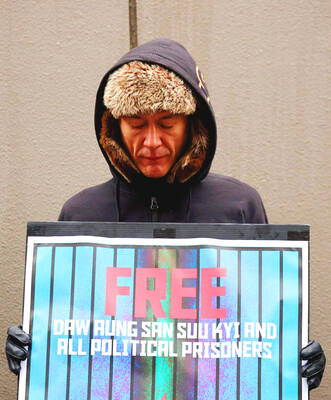"We mean no harm! We mean no harm!" shouted the rebel leader as his men laid booby traps around a downtown mall and luxury apartment building here early Sunday morning.
For the next 18 hours, a band of 300 junior military officers and troopers barricaded themselves inside the apartment building and demanded the resignation of the president and defense secretary and better equipment for soldiers in the field.
By the time they gave up and agreed to return to their barracks Sunday evening, it was clear that this had been only a caricature of the coups and popular putsches that have kept the country on edge for the past 18 years.
No shots had been fired; indeed, no guns had been pointed. No real threats had been made by either side. An overheated news conference was the mutineers' main action, and fatherly talks by senior officers brought the squall to an end.
Coup rumors are so common here that most people, while enjoying a frisson of worry, tend to discount them. The current rumors had been circulating for a week -- ?some here say the mutiny was delayed by weather when a typhoon struck.
President Gloria Macapagal Arroyo may have spurred the rebels into action when she ordered the arrest on Saturday of "a small band of rogue junior officers."
The soldiers' passion was very real, though, and some of their grievances -- ?corruption and bad management in the military -- ?seemed justified. But as the political scientist Alex Magno said, they were "pretty naive."
"We hope the Filipino people will get our message," said the rebel leader, Lieutenant Antonio Trillanes of the navy, although he never made the message quite clear. "Maybe we can change the system."
"Hooray!" his men shouted as reporters besieged them in the lobby of the apartment building.
"Of course, they are very emotional," said Glenda Gloria, an expert on the military and the Muslim insurgency in the southern Philippines. "Some were trained by the United States, and the United States is very much aware of how mismanaged the armed forces is."
Ineffectual as it was, the brief standoff offered a lesson in the patterns history sets. In a country where coup attempts were at one time almost routine and where two presidents have been ousted when the military turned against them, it was only a short step for these young officers from disaffection to mutiny.
When they dismantled their booby traps and returned to their barracks, grumbling that nothing had changed, they took with them a promise by their commanders to address their grievances.
That light touch from the commanders also followed a pattern that was set in the first of half a dozen coup attempts in the 1980s against Corazon Aquino, who was president at that time. In that case, soldiers who took over the Manila Hotel were sentenced only to a round of push-ups before being sent back to their barracks.
The most dangerous and dashing of the coup leaders from those years, Gregorio Honasan, is now an overweight senator and has declared his candidacy in the next presidential election.
Mutiny is not necessarily a career-ending move in the Philippines, and as Honasan showed in the 1980s, it can be addictive.
Some officials said they had evidence that he had somehow been involved in Sunday's action but any possible backing for the mutiny remained unclear.
The mutineers, slipping on red armbands with a white sunburst, secured the Glorietta Mall and the Oakwood Premier apartments at 3am Sunday. The shopping center was also the scene of the final big attempt against Aquino, in 1989, after which the rebels were allowed to march out in formation.
The luxury apartments house many foreigners, including the ambassador of Australia, but by late morning all residents had been freed except, according to a local report, two who overslept.
The center of Makati, the city's business district, was sealed off by troops and armored personnel carriers and the streets were empty as Arroyo addressed the mutineers on television.
"This is your commander in chief," declared Arroyo, who has worked hard to cultivate an image of resoluteness. "Even if you think you can gain political power in this way, which you cannot, you will realize that there is no substitute for democracy and constitutional means to solve the problems of our people."
Arroyo's presidency is itself the product of a mutiny in January 2001 when the military, responding to clamorous crowds in the streets, told the incumbent, Joseph Estrada, that it was "withdrawing its support."

The Burmese junta has said that detained former leader Aung San Suu Kyi is “in good health,” a day after her son said he has received little information about the 80-year-old’s condition and fears she could die without him knowing. In an interview in Tokyo earlier this week, Kim Aris said he had not heard from his mother in years and believes she is being held incommunicado in the capital, Naypyidaw. Aung San Suu Kyi, a Nobel Peace Prize laureate, was detained after a 2021 military coup that ousted her elected civilian government and sparked a civil war. She is serving a

‘NO AMNESTY’: Tens of thousands of people joined the rally against a bill that would slash the former president’s prison term; President Lula has said he would veto the bill Tens of thousands of Brazilians on Sunday demonstrated against a bill that advanced in Congress this week that would reduce the time former president Jair Bolsonaro spends behind bars following his sentence of more than 27 years for attempting a coup. Protests took place in the capital, Brasilia, and in other major cities across the nation, including Sao Paulo, Florianopolis, Salvador and Recife. On Copacabana’s boardwalk in Rio de Janeiro, crowds composed of left-wing voters chanted “No amnesty” and “Out with Hugo Motta,” a reference to the speaker of the lower house, which approved the bill on Wednesday last week. It is

‘EAST SHIELD’: State-run Belma said it would produce up to 6 million mines to lay along Poland’s 800km eastern border, and sell excess to nations bordering Russia and Belarus Poland has decided to start producing anti-personnel mines for the first time since the Cold War, and plans to deploy them along its eastern border and might export them to Ukraine, the deputy defense minister said. Joining a broader regional shift that has seen almost all European countries bordering Russia, with the exception of Norway, announce plans to quit the global treaty banning such weapons, Poland wants to use anti-personnel mines to beef up its borders with Belarus and Russia. “We are interested in large quantities as soon as possible,” Deputy Minister of National Defense Pawel Zalewski said. The mines would be part

Cozy knits, sparkly bobbles and Santa hats were all the canine rage on Sunday, as hundreds of sausage dogs and their owners converged on central London for an annual parade and get-together. The dachshunds’ gathering in London’s Hyde Park came after a previous “Sausage Walk” planned for Halloween had to be postponed, because it had become so popular organizers needed to apply for an events licence. “It was going to be too much fun so they canceled it,” laughed Nicky Bailey, the owner of three sausage dogs: Una and her two 19-week-old puppies Ember and Finnegan, wearing matching red coats and silver